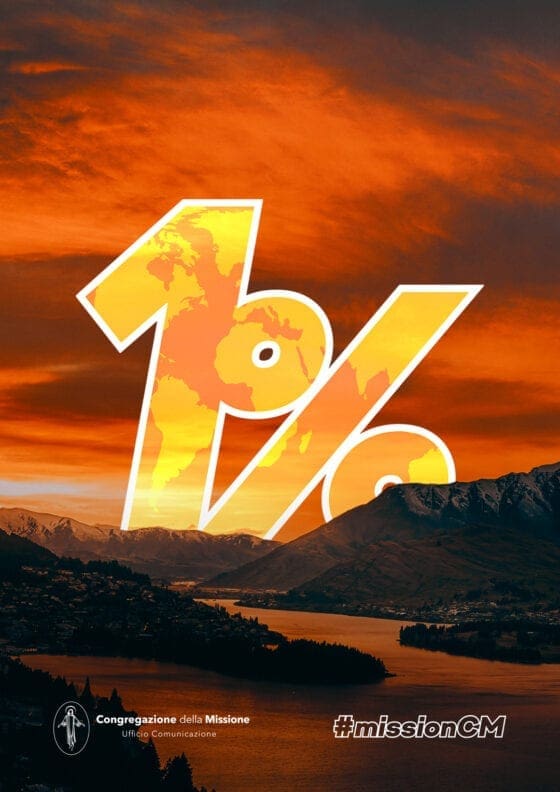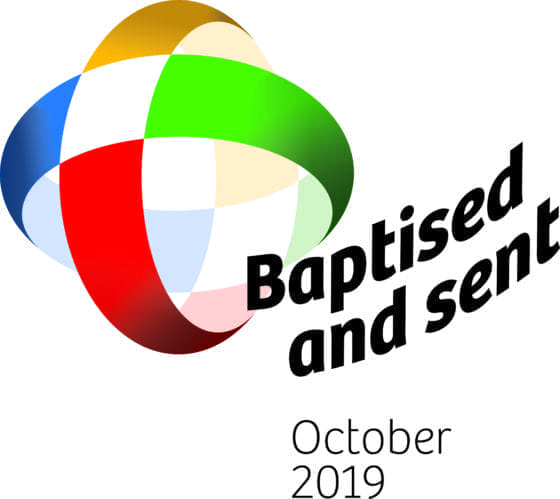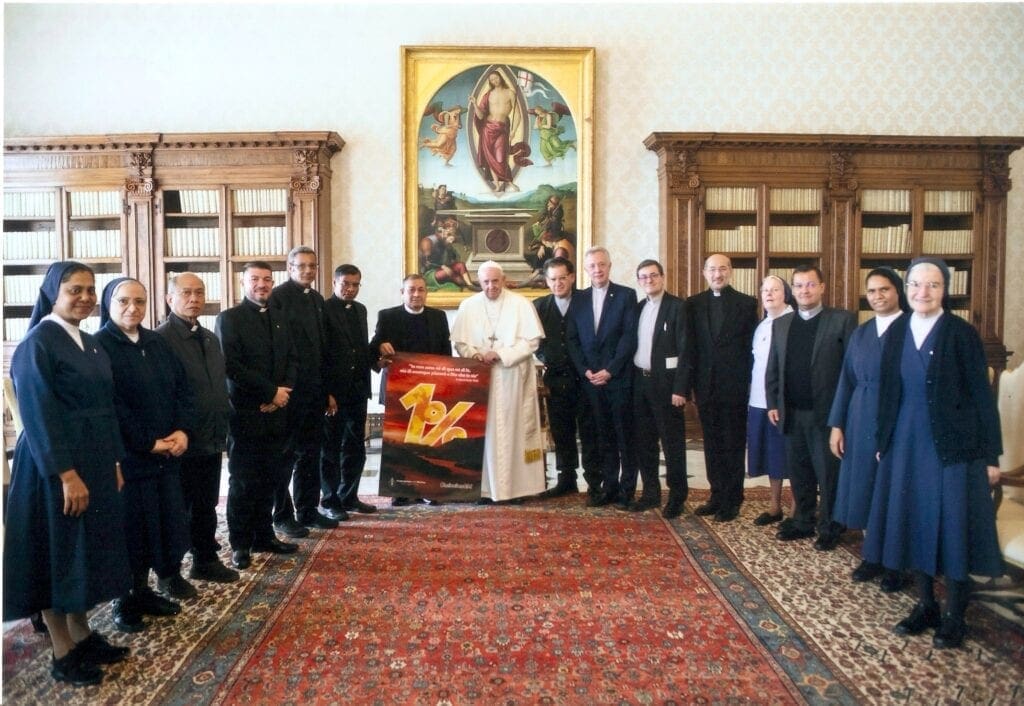Rome, 20 October 2019
My dear confreres,
May the grace and peace of Jesus be always with us!
In the recent video message for this year’s extraordinary Mission Month of October, Pope Francis shares the following words with us and the whole Church:
“Today, a new impulse to the Church’s missionary activity is needed to face the challenge of proclaiming Jesus and his death and resurrection. Reaching the peripheries – the human, cultural, and religious settings still foreign to the Gospel: this is what we call the missio ad gentes. We must also remember that the soul of the Church’s mission is prayer. In this extraordinary missionary month, let us pray that the Holy Spirit may engender a new missionary spring for all those baptized and sent by Christ’s Church.”
The theme for the extraordinary Mission Month of October 2019 is
“Baptized and Sent: The Church of Christ on Mission in the World.”
In last year’s Mission Appeal Letter, I had invited all the confreres around the world to get involved in the initiative:
“To send 1% of the members of the Congregation of the Mission to the missions ad Gentes.” The 1% of our overall membership of around 3000 confreres comes to 30 confreres, who would go as new missionaries to the missions “ad Gentes.”
The concrete invitation and challenge for the worldwide Congregation was that in response to the invitation of Pope Francis for the extraordinary Missionary Month of October 2019, our Little Company would be able to present Pope Francis, in writing, the following:
Holy Father, the Congregation of the Mission after praying, reflecting, and discussing the different possibilities within the Congregation, based on your invitation to the Universal Church, is delighted and overwhelmed with joy for God’s mercy toward us. We are announcing, Your Holiness, in this month of October 2019, that our “Little Company” is sending 1% of its membership, that is, 30 confreres, as new missionaries to the missions “ad Gentes.”
Dear confreres, with overwhelming joy, in humility, and being very aware of Jesus’s vivid sign of mercy toward our Congregation, I announce that we reached the goal we had set for ourselves last year. Confreres will be sent to our different missions “ad Gentes,” mostly in a very short period of time, some in one, two, or three years.
We surely took Pope Francis’s words and invitation to heart when he invited all the baptized to a new missionary spring. The concrete signs of the missionary spring within our Little Company are seen clearly.
Thank you so very much, dear confreres of the whole Congregation. This is the fruit of the Spirit in the first place. However, it is also your fruit for you participated in this initiative through your prayers, sufferings, encouragement, and support. Therefore, today, our confreres will be prepared to go announce the Gospel to the farthest corners of the world, wherever Providence is calling us.
However, this overwhelming response will not be a true sign of a missionary spring within our Little Company if this spirit remains here and does not continue into the future. I would like to invite and encourage all of us to pray and support our confreres, who will apply now to go to the mission “ad Gentes.” I would like to invite and encourage you, who feel the call to go to the mission “ad Gentes” on the basis of this year’s mission appeal, after prayer, discernment, and discussion with your Visitor, to write to me, volunteering to go to one of our many missions around the world that are so much in need.
The sooner you write, the sooner we will be able to discuss it in the General Council, and the sooner we will be able to respond to the many requests for help. As I had mentioned in my previous letter, if you feel called to the missions ad Gentes but, because of present commitments in the place where you serve, cannot go immediately, you can volunteer today, adding that you will be available in one or two years.
Here are the missions that, at this moment, need special attention and volunteers:
Alaska: There are two confreres, one from India and the other from the United States, based in the co-cathedral of Anchorage. Another confrere from Colombia will join the mission in January 2020. The mission serves Spanish-speaking populations in Anchorage, Wasilla, Kodiak, and Fairbanks. However, the need for priests to serve widely dispersed small communities throughout the three dioceses of Alaska is great. The languages needed are English and Spanish. The mission could expand to the Juneau Diocese if another confrere, who speaks only English, joins. The ability to drive an automobile is essential. Strong pastoral skills are also necessary.
Chad: This is a joint mission of the Superior General and his Council and COVIAM. The former provide financial support and the latter provides personnel. This mission has expanded over the years. It began in Bebalem in 2011. With the request of the Bishop of Moundou, it extended to Saint John Paul II Minor Seminary of Moundou in 2016. This year it moved into another diocese, that of N’Djamena, the capital city of Chad. The Archbishop of N’Djamena wanted the Congregation of the Mission in his archdiocese principally to revitalize the minor seminary, which had ceased to function. This international mission, therefore, is now operating in three places: Bebalem, Moundou, and N’Djamena. There are seven missionaries, all Africans, from COVIAM. Next June 2020, one missionary will conclude his missionary work. Therefore, another confrere will have to replace him. The ministries of this mission are parish work and seminary formation. It is going well and the bishops with whom we are working are happy and satisfied.
Tunisia: This mission began “ad-experimentum” in 2011. The formal beginning was in September 2012. The official languages of Tunisia are Tunisian Arabic and French. Our mission began at “La Goullette,” very close to Tunis, the capital city of Tunisia. Because of its particularity, this mission has had a number of missionaries and is now in a process of reconfiguration. We do not yet know what its internal reconfiguration will be. For now, it is operating in La Goullette and Sousse, where we have three missionaries, all from COVIAM.
Papua New Guinea: This is considered a Christian country, with a total population of around eight million. Its Catholic population is about 30%. The Church in PNG is comparatively young, facing many challenges. It needs the help of missionaries to grow and develop. Our mission there began in 2001. Presently, nine confreres are rendering their services to the PNG mission: two from Poland, three from the Philippines, two from Vietnam, one from Colombia, and one from the Oceania Province. The Vincentians are engaged in several ministries: spiritual formation of the diocesan seminarians at Holy Spirit Seminary, pastoral care and laity formation, social developmental activities, and staffing the Melanesian Institute. The confreres working in PNG would like to have more members. Evangelization possibilities are very high. Anyone who is committed and willing to face challenges is most welcome to join our efforts in PNG. Volunteers need to have a good command of the English language and should be prepared to learn the local language.
Bolivia: Last year there was talk of reconfiguring the missions in Bolivia. For about a year, the confreres of the three communities have gathered in Cochabamba to form a community center, from which to begin a joint missionary program and organize the pastoral work of the missions. The missions are: “El Alto,” whose contract ends this October and whose situation is under study; “Kateri,” in the city of Trinidad, Beni, which is a young mission and is still organizing and developing its program; and “Huayllani” in Cochabamba, which continues its established mission work. At this time, there are only four missionaries remaining. We are expecting the arrival of a confrere at the beginning of 2020. There are other encouraging possibilities. Overall, evangelizers still are lacking and we hope that we can count on at least six to eight permanent missionaries to establish the Congregation in Bolivia. We need someone who can work in vocation ministry and another to start a formation program.
Angola: Due to lack of personnel, we long had only one missionary in the Mission of Lombé, (Archdiocese of Malange). There are currently two, but we are waiting for a third, a confrere from Congo. We dream of forming a community of five, with more stability and better chances of developing what has been done so far. Despite the shortcomings of personnel, the confreres are to be congratulated for the work that has been carried out. Lombé is a mission with many perspectives. The main concern is to involve and train lay people and religious according to the Archdiocese’s pastoral plan. Apostolic visits to the various rural communities occupy a good part of the time. The missionaries also encourage and support the development of the Vincentian Family whose presence in the mission is evolving well. The mission is widespread and there is abundant poverty. The field of missionary work is huge. The geographical conditions require good physical health. The language is Portuguese.
Costa Rica: Talamanca is the most important indigenous territory in Costa Rica and is located in the southern Atlantic part of the country. From its origins, the mission there has been the responsibility of the Congregation of the Mission. The missionary service has two realities: the parish life that provides monthly pastoral care to about 30 hard-to-reach communities (navigating the rivers, on motorcycles, or by walking) and the mission ad gentes, where it takes up to five days walking in the mountains to visit hundreds of people living in miserable conditions. The indigenous languages are Bribri and Cabécar, but, in most communities, it is possible to communicate in Spanish. Recently the Province of Colombia offered a missionary for 2020, but at least one more missionary is needed.
Cuba: This province is beginning a process of reconfiguration with a project developed with the missionaries who are working there: two Cuban confreres, three from the Province of Colombia, one from Haiti, one Mexican, and one Brazilian. In addition, two local seminarians will receive priestly orders soon. Until now, Gilbert Walker, whom we thank for all his efforts in Cuba, carried out the responsibility of coordinating the missionaries. As of 20 October 2019, the service will be taken over by Orlando Escobar (from Colombia). He will endeavor to develop the reconfiguration plans put in place this past June.
This is a difficult time for what we dream is endangered by two involuntary absences: Father Margarito returned to his home province of Mexico for healthcare. Father Fantico, from the Province of Fortaleza, died at the age of 49. An elderly missionary, who gave his life in Cuba, also died. He was called, colloquially, Father Cuevitas. To both deceased we offer our suffrages.
Two important gaps remain: formation and vocation ministry, which may well involve two missionaries; and, at least two more missionaries to complete the pastoral needs of the Shrine of Our Lady of Mercy and the Parish of the Miraculous Medal, both in Havana. The Parish of San Luis (Santiago de Cuba) has more personnel (four confreres) and fewer difficulties. With all our strength, we ask Divine Providence, in whom we trust, to move the hearts of missionaries to offer to help strengthen us in the missionary situation of Cuba. We trust that two Cuban missionaries will be ordained soon, which speaks of vocational hopes for the future.
Honduras: Three provinces are engaged in various Honduran territories. The Province of San Vicente de Paul, Spain, has missions in La Mosquitia, in San Pedro Sula, and in Tegucijalpa. The Province of Slovakia has a mission in Sangrelaya, which is a group of small islets between the sea and the waters of lagoons and rivers. The Province of Saragossa has the missions of Cuyamel and Puerto Cortés.
We are particularly concerned with the missions of “La Mosquitia,” in the Diocese of Trujillo, where our confrere, Luis Solé Fa, is bishop. The diocese is poor in resources and poor in personnel. It is a vast territory, difficult to access, in many parts only by plane or boat, due to the inhospitable terrain. Helping in these areas can be a beautiful missionary experience, but, above all, a true gesture of charity, fraternity, and dedication. The needs are many and the workers are few.
Guatemala: The Sayaxché Mission, in an indigenous territory with diverse ethnicities of Mayan culture and dialectical ramifications, has been cared for pastorally for many years by the Province of Central America. Now only one missionary ministers there. It is located in the immediate vicinity of Petén, a jungle area with difficult access to the interior towns, especially when it rains. The Province is restructuring its ministries, but not with good omens for these missions that are an excellent ground for the missionary formation of its seminarians. It would take at least two more confreres to support such a missionary and Vincentian work.
Argentina: The Province of Argentina is forming a team to help our confrere, Bishop Vicente Bokalic, in the Mission of Ojo de Agua in its territory of Santiago del Estero. It is a young diocese with many needs in the field. Even though the confreres have a center where they will live, the idea is to evangelize those rural areas with “popular missions,” and other related activities.
Mozambique: The Vice-Province is small, with about 20 missionaries, although vocations are not lacking. This makes us think that, in the future, it will have more personnel. It currently needs missionaries to carry out its open works that cannot be left easily. It requests the help of three missionaries specifically for: formation in the Internal Seminary, working in a team with others; the Magude mission, to work with two Mozambican priests; and the Tete mission or the Nacala parish mission. The language spoken is Portuguese. Therefore, one must be willing to learn that language.
Panama: The entire region is a mission work. Of special note are the areas in the Province of Chiriquí (on the border with Costa Rica), the Comarca of Soloy (which serves an indigenous population, where the World Indigenous Youth Gathering was held), and the Province of Colón (the mission in Escobal and the City of Colón, the poorest city in Panama). The principal mission languages are Spanish, Ngobe, and Vietnamese. There is a need for two confreres in Puerto Armuelles, one in Concepción, and one in Soloy, for a total of four.
Russia: The Mission in the city of Nyzhniy Tagil is under the supervision of the Vice-Province of Saints Cyril and Methodius. The mission needs men who can obtain visas for Russia. The work is slow, mostly Eucharist on Sunday in three small parishes requiring 350 kilometers of travel. There is also collaboration with the Daughters of Charity, the Association of the Miraculous Medal, and some other Vincentian Charism groups. The Province of Vietnam is preparing men to join this mission. The language of ministry is Russian.
May Our Lady of the Miraculous Medal, Saint Vincent the Paul and all the Saints, Blessed, and Servants of God of the Congregation of the Mission, as well as of the whole Vincentian Family, intercede for us!
Your brother in Saint Vincent,




